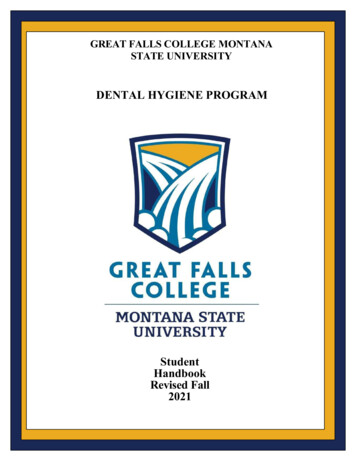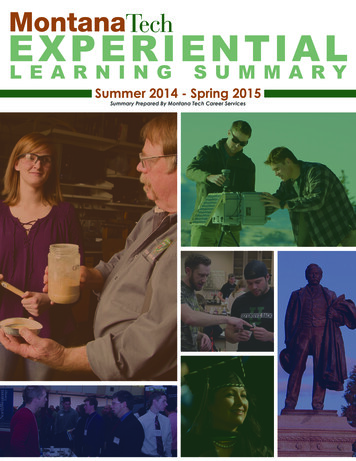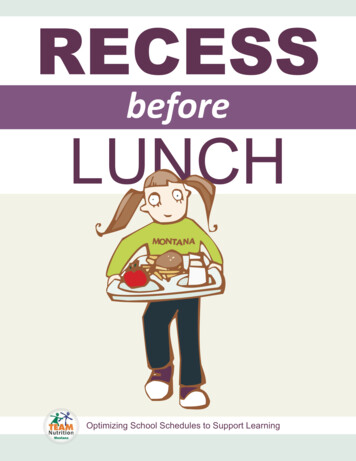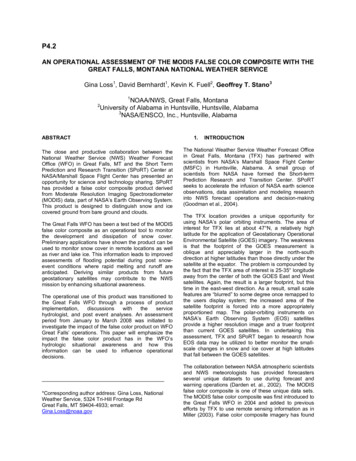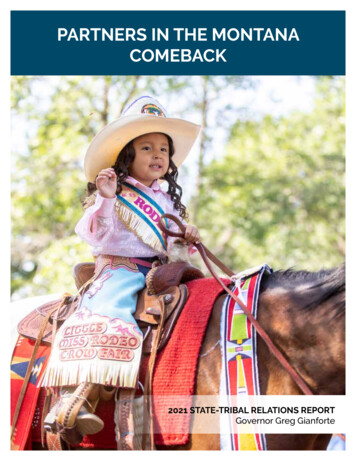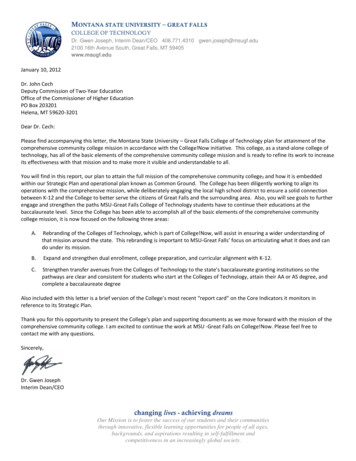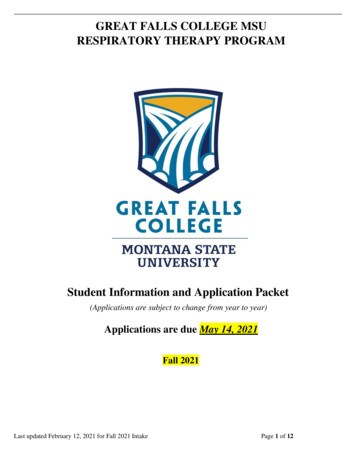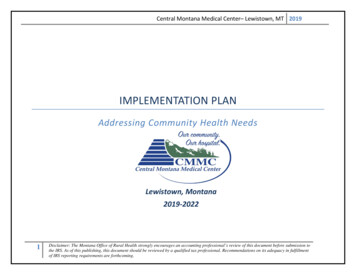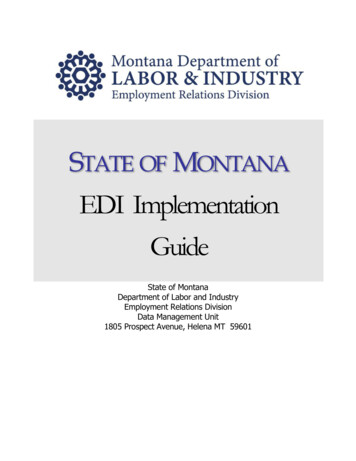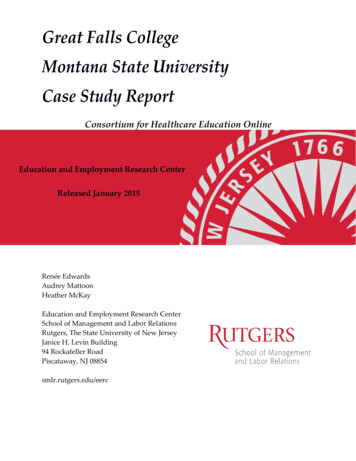
Transcription
Great Falls CollegeMontana State UniversityCase Study ReportConsortium for Healthcare Education OnlineEducation and Employment Research CenterReleased January 2015Renée EdwardsAudrey MattoonHeather McKayEducation and Employment Research CenterSchool of Management and Labor RelationsRutgers, The State University of New JerseyJanice H. Levin Building94 Rockafeller RoadPiscataway, NJ 08854smlr.rutgers.edu/eerc
Great Falls CollegeMontana State UniversityCase Study ReportConsortium for Healthcare Education OnlineRenée EdwardsAudrey MattoonHeather McKayEducation and Employment Research CenterSchool of Management and Labor RelationsRutgers, the State University of New JerseyJanice H. Levin Building94 Rockafeller RoadPiscataway, NJ 08854December 2014This workforce solution was funded by a grant awarded by the U.S. Department of Labor’s Employmentand Training Administration. The solution was created by the grantee and does not necessarily reflect theofficial position of the U.S. Department of Labor. The Department of Labor makes no guarantees,warranties, or assurances of any kind, express or implied, with respect to such information, includinginformation on linked sites and including, but not limited to, accuracy of the information or itscompleteness, timelines, usefulness, adequacy, continued availability, or ownership.2
ABOUT RUTGERS SCHOOL OF MANAGEMENT AND LABOR RELATIONSRutgers' School of Management and Labor Relations (SMLR) is the leading source of expertiseon the world of work, building effective and sustainable organizations, and the changingemployment relationship. The school is comprised of two departments—one focused on allaspects of strategic human resource management and the other dedicated to the social sciencespecialties related to labor studies and employment relations. In addition, SMLR provides manycontinuing education and certificate programs taught by world-class researchers and expertpractitioners.SMLR was originally established by an act of the New Jersey legislature in 1947 as the Instituteof Management and Labor Relations (IMLR). Like its counterparts that were created in the otherlarge industrial states at the same time, the Institute was chartered to promote new forms oflabor-management cooperation following the industrial unrest at the end of World War II. Itofficially became a school at the flagship campus of the State University of New Jersey in NewBrunswick/Piscataway in 1994. For more information, visit smlr.rutgers.edu.ABOUT THE EDUCATION AND EMPLOYMENT RESEARCH CENTERRutgers’ Education and Employment Research Center (EERC) is housed within the School ofManagement and Labor Relations. EERC conducts research and evaluations on education andworkforce development programs and policies. EERC research expertise includes communitycolleges, state and federal workforce developmental systems, skills development, collegecompletion, and innovative and technology-based programs.3
INTRODUCTIONThe Consortium for Healthcare Education Online (CHEO) is a United States Department ofLabor (USDOL) Trade Adjustment Assistance Community College and Career Training(TAACCCT) funded grant project intended to develop new or redesigned online and hybridcourses leading to credentials in health care fields in high demand across the West andMidwest. CHEO is an interstate consortium consisting of eight colleges across Colorado,Wyoming, South Dakota, Montana, and Alaska. The consortium includes Pueblo CommunityCollege (PCC), Otero Junior College (OJC), Red Rocks Community College (RRCC), LaramieCounty Community College (LCCC), Lake Area Technical College (LATI), Great Falls CollegeMontana State University (GFC MSU), Flathead Valley Community College (FVCC), andKodiak College (KoC).Each of the eight colleges is required to integrate the following components into itsprogram/course design/redesign: 1) open education resources (OER), 2) use of the NorthAmerican Network of Science Labs Online (NANSLO), 3) a CHEO-funded career coach, and 4)use of the CHEO Health Career Hub.Open education resources (OER) are teaching tools and resources that are licensed for free,public use. They include teaching, learning, and research resources that reside in the publicdomain or have been released under an intellectual property license that permits their free useand re-purposing by others. Open educational resources include full courses, course materials,modules, textbooks, streaming videos, tests, software, and any other tools, materials, ortechniques used to support access to knowledge.Under the CHEO grant, consortium colleges are encouraged to use OER resources in thecreation/redesign of their online or hybrid courses. Consortium colleges are also required tocreate or redesign their courses/programs so that they can be packaged and licensed OER foruse by other educators and institutions. The CHEO colleges will package, license, and post theircourse material during the course of the grant. OER materials will be uploaded to a skillscommons repository under MERLOT. The MERLOT skills commons repository consists ofdiscipline-specific learning materials, learning exercises, and web pages, designed to enhancethe teaching experience.The North American Network of Science Labs Online (NANSLO) is a remotely operated roboticlab designed to innovate the distance lab experience for students through a web-based portal.CHEO partners will collaborate to develop lab exercises to be used in health- and sciencerelated courses. Faculty in the designed/redesigned CHEO programs will incorporate thedeveloped labs into courses, using one of the three NANSLO nodes. Nodes are equippedlaboratories that remotely run the specified labs for consortium colleges. Three total nodes exist,one newly created under the CHEO grant at GFC MSU. The other two nodes are located atNorth Island College in Vancouver, British Columbia, and RRCC in Denver, Colorado.1
The NANSLO science lab network is managed by the Colorado Community College System(CCCS). For the purposes of the CHEO grant, the Western Interstate Commission on HigherEducation (WICHE) in Boulder, Colorado serves as the public’s primary resource forinformation about NANSLO. WICHE coordinates communication among the network’s labpartners and coordinates the faculty discipline panels that plan and develop individual scienceexperiments for the nodes.WICHE additionally serves as CHEO’s professional development coordinator, schedulingwebinars and workshops for instructional designers, faculty and career coaches through threeyears of the grant. Specifically, in the first year of the grant, WICHE was responsible for oneface-to-face workshop that included instructional designers and faculty members, a separateface-to-face workshop for career coaches, and four webinars (two for faculty and two forcoaches). In the second year of the grant, WICHE was responsible for a face-to-face workshopfor faculty and one for coaches, as well as six webinars (three for faculty and three for coaches).In the third year of the grant, WICHE is responsible for one face-to-face workshop for facultyand one for coaches, in addition to six webinars (three for faculty and three for coaches). Ifsubsequent support during any grant-funded year is deemed necessary, the PCC CHEOadministration team is responsible. For example, based upon project needs relative to employerengagement and job placement, a second face-to-face workshop was provided for coaches inyear three. The PCC CHEO team also provides organization and facilitation of annual face-toface meetings for project leads. Additionally, 10 trainings for the CHEO Health Career Hub arethe responsibility of College in Colorado. Hub trainings began in year two and extend into yearthree.Each college in the consortium is required to employ a career coach to collaborate withemployer partners, local workforce centers, community and nonprofit organizations, andstudents to ensure student access to CHEO resources. Within each of these areas ofcollaboration, coaches work according to their institution’s needs to build CHEO programs,recruit and retain students for CHEO programs, and assist students in multiple ways as eachinstitution designates. Coaches also track their interactions with students to report outcomesbased on a model of “intensive advising,” assisting students throughout their education withmultiple interactions and points of intervention to ensure student success and, ultimately,employment.The CHEO Health Career Hub is a sophisticated regional and web-based portal that promotesand supports those pursuing a career in health care fields with a wide variety of high-impactinteractive tools and services. PCC, the lead applicant and fiscal agent for the CHEO grant, hasworked with College in Colorado hub development and Kuder, a company that designs onlinecareer planning systems, to create the CHEO hub. The hub is to be used as a case managementtool by coaches and as an interactive career management tool for students in CHEO programsacross all eight consortium colleges.2
This report is one of eight created to highlight each individual college’s contributions to theCHEO project to date. The purpose of this case study is to provide a summary of GFC MSU’sactivities, successes, and challenges to date and to identify the best practices, innovativestrategies, and unique contributions of the college to the CHEO project to date. This case studybegins with an overview of its methodology and data sources and then moves on to thecontextual frame—demographic and socioeconomic background information about GFC MSU,its student population, and its service region. These sections are followed by a) a summary ofthe goals of GFC MSU’s CHEO program, b) a discussion of the baseline targets and subsequentchanges relative to the CHEO project, c) the identification of GFC MSU’s emerging bestpractices, innovative strategies and unique contributions to CHEO, and d) a summary ofsuccesses and challenges to date along with next steps.METHODOLOGY/DATA SOURCESThis report examines the development and implementation of the first two years of the CHEOgrant at GFC MSU, including experiences of the project team members and participating staff,faculty, and students. As such, this report uses qualitative data and analysis. Subsequent EERCevaluation reports will include outcome measures and report on quantitative data collectionand analysis.The qualitative methodology for this report includes content analysis of consortium goals andactivities to date, relevant proposals, and project- and college-specific statements of work,quarterly reports, career coach tracking spreadsheets (also called “stitched-in reports”), strategicplan information and materials, and websites developed by individual colleges. EERC teammembers have also conducted phone and in-person interviews with the CHEO coordinator,grant administrators, senior WICHE administrators, college project leads, NANSLO DisciplinePanel participants, and faculty and career coaches. EERC team members have also beenparticipant–observers at many project workshops including those for faculty, project leads,instructional designers, and career coaches. Finally, members of the EERC team have“observed” conference calls with project leads and career coaches and joined in webinars.Most interviews were taped and transcribed; non-taped interviews involved extensive notetaking. These transcriptions and notes as well as the documents cited above have been codedthrough the use of NVivo qualitative data management software and analyzed by EERC teammembers to represent each college’s individual story relative to the CHEO project.As noted above, while quantitative analysis will be presented in subsequent reports, thissummary is meant for contextual purposes only and will only utilize data from qualitativeanalysis. For this reason, grant targets relative to each college, student counts, course counts,NANSLO lab counts, industry- and workforce-related targets, and other quantitative objectiveswill not be discussed as part of this report.3
COLLEGE DESCRIPTION AND OVERVIEW OF STUDENT POPULATIONEstablished in 1969, GFC MSU is a small, urban, non-residential two-year institution located inGreat Falls, Montana. Part of Montana State University, GFC MSU is affiliated with other MSUcampuses, including the main campus in Bozeman, and two other campuses: MSU-Northern inHavre, and MSU-Billings located in Billings.1 GFC MSU offers 42 associate degree programsand 29 certificate programs in eleven different fields, the most popular of which include healthprofessions, sciences, general studies, liberal arts, and humanities.2 GFC MSU offers nineteenhealth science programs, the largest number of health science programs offered at any Montanacollege.3GFC MSU mostly recruits local residents of Cascade County, but also attracts many residentsfrom neighboring, rural counties, including: Teton, Pondera, Chouteau, Glacier, etc. Since thecollege offers so many health care programs, it is a “go-to” school for all the outlying areas,including areas with other colleges that do not offer the same programs. In addition, GFC MSUprides itself as being a “military friendly school,” helping military and veteran students fulfilltheir education and career needs.4 For example, Malmstrom Air Force Base is located justoutside Great Falls, which makes GFC MSU convenient for students from military families. Arange of online and hybrid courses offered by GFC MSU allow easier access to education byresidents of the surrounding rural communities as well as military members and their spouses.During the 2013 academic year, 39 percent of GFC MSU students enrolled in online classes andsix percent in hybrid format classes.5According to the enrollment data for fall 2013, the majority of students attending GFC MSU didso part-time (53 percent, N 983). GFC MSU serves far more female than male students; 72percent of the student population were female in 2013. Just over 50 percent of students (N 942)are considered to be of “non-traditional” college age (25 years or older), and about 13 percent(N 238) of students identified themselves as racial minorities, the primary category beingAmerican Indian (N 139).6“About Us: GFC MSU,” Great Falls College MSU, accessed September 5, 2014,http://www.gfcmsu.edu/about/index.html.2 “Community Colleges: Great Falls College Montana State University,” U.S. News & World Report, accessedSeptember 5, 2014, 03.3 “Fact sheet,” Great Falls College MSU, accessed September 5, PDFs/Factsheet.pdf.4 “Military and Veteran Students,” Great Falls College MSU, accessed September 5, .5 Great Falls College: Fact Book 2013-2014, Great Falls College MSU, accessed September 5, PDFs/GFCMSU Factbook 1314.pdf.6 Great Falls College: Fact Book 2013-2014. Great Falls College MSU, accessed September 5, PDFs/GFCMSU Factbook 1314.pdf.14
GFC’S CHEO GOALSGFC MSU felt the CHEO grant was well-aligned with its goals already in progress: buildingstrong health care program offerings for students, and serving an online population. Eight ofthe nineteen health care programs the college currently offers are completely online. The CHEOgrant offered GFC MSU the opportunity to further expand its health care programs and bring inmore technology and innovations to improve the student experience.Within this overarching concept, GFC MSU had two primary goals at the outset of the CHEOgrant. The first was to improve and expand its allied health program capacity at the college, andthe second was to build off previous NANSLO experience to create a new NANSLO nodehoused at GFC MSU. Health care is one of the leading industries in terms of job growth inMontana; future projections suggest 27 percent growth between 2010 and 2020.7 Montanafollows national trends in that the aging population of baby boomers is approaching theretirement age. The large population of elderly in Montana, which has one of the oldestpopulations in the nation, and the increasing life expectancy of the population all create moredemand for health care services.8 Additionally, job growth in the health care industry outpacesjob replacement, creating a shortage of health care workers, especially in rural areas.9Job growth for phlebotomists is expected to be 27 percent nationally between 2010 and 2022,and 25 percent in Montana, over twice the state average of projected occupation growth in nonhealth care fields.10 In 2013, phlebotomists in Montana made an average of 29,040, just shy ofthe national average ( 31,410).11 Job growth for EMTs and paramedics is also projected to bemuch faster than average job growth: 27 percent nationally and 25 percent in Montana. Anincreased demand for these occupations will continue in rural areas and smaller metropolitanareas.12 EMTs and paramedics made 34,870 in 2013 nationally, although these positions madeless in Montana ( 28,010) and even less in the Central Montana nonmetropolitan area ( 27,340).Health Care Workforce: An Important Part of Montana's Economy, Juliar, K., Montana Department of Labor andIndustry, last modified Spring 2014, accessed July 31, 2014, 42014.pdf.8 Health Care Labor Shortages and Potential Solutions, Connell, W., Montana Department of Labor and Industry,Research and Analysis Bureau, last modified January 2013, accessed August 1, 0and%20Potential%20Solutions.pdf.9 Health Care Labor Shortages and Potential Solutions, Connell, W., Montana Department of Labor and Industry,Research and Analysis Bureau, last modified January 2013, accessed August 1, 0and%20Potential%20Solutions.pdf.10 “Phlebotomists,” Occupational Outlook Handbook, Bureau Of Labor Statistics, last modified January 8, 2014, accessedSeptember 8, 2014, http://www.bls.gov/ooh/health care/phlebotomists.htm.11 “Occupational Employment Statistics,” Bureau of Labor Statistics, last modified April 1, 2014, accessed September8, 2014, http://www.bls.gov/oes/current/oes mt.htm#29-0000.12“EMTs and Paramedics,” Occupational Outlook Handbook, Bureau Of Labor Statistics, last modified January 8, 2014, accessedSeptember 8, 2014, http://www.bls.gov/ooh/health care/emts-and-paramedics.htm#tab-1.75
The average wage in Montana, especially in the rural areas, may be a result of the numbers ofvolunteers that engage in such positions.13It should be noted that students graduating with their AAS in medical assisting can then go onto virtually any health care program, including nursing, at MSU. Students can go straightthrough, or they can exit with their AAS, test, work for a period of time, and then go on to MSUor come back to GFC MSU, stack another certificate if they wish, and go on to MSU. Also, once astudent has his or her AAS in medical assisting, there are many paths to employment that donot require continuation of education. Medical assistants can take x-rays, run equipment, dobloodwork, and work with medications. With these skills, they are more hirable thanprospective employees that can do only one of those things, such as radiologic technicians.While the rate of pay for medical assistants is lower than a radiologic technician could expect,the number of jobs are higher and employers are happier to have someone who can do a rangeof duties.GFC MSU was involved with the Next Generation Learning Challenges (NGLC) grant, whichexpanded the capacity and reach of NANSLO labs. GFC MSU played a small role in this grantproject by serving on the advisory board and some faculty members were engaged in thecreation of labs. When the opportunity arose for GFC MSU to house a NANSLO node at thecollege through the CHEO project, it jumped at the chance. The new node would serve theMontana area consortium colleges for the CHEO grant and would expand for future projects toserve as a node for other education institutions. GFC MSU is now the third NANSLO node,joining the nodes at Red Rocks Community College in Denver, Colorado, and the node at NorthIsland College in Vancouver, British Colombia.By housing the node at the college, not only is GFC MSU involved in expanding the reach ofNANSLO labs to a geographic area previously untouched by the remote labs, but the collegewill also be able to expand its own online and hybrid course offerings through its allied healthprograms by using the lab. Currently, both GFC MSU and its Montana CHEO counterpart,FVCC, are using the GFC MSU node, but the college has plans for expanding it to other schoolsand for community use in the future.GFC MSU is independently accredited, but is organizationally aligned with MSU Bozeman.GFC MSU hires, trains, and evaluates its own faculty, sets its own learning objectives,assessments, program outcomes, etc., but the college works closely with MSU Bozeman, whichis the flagship university. Some purchasing and IT-related issues go through MSU Bozeman,and some campus policies are handed down, although GFC MSU is able to make modificationsto fit its own campus. The relationship is beneficial in many ways, including the ability topurchase software licenses for less since fees are often based on “head counts,” and, when GFCMSU is included with MSU Bozeman, enrollment numbers are high. Also, students have access2014-2015 Catalog, Great Falls College MSU, accessed September 5, Pre-Paramedic%2014-15.pdf.136
to all the MSU system resources, which includes the MSU library. The schools also sharearticulation agreements in multiple programs. Although Montana went through a commoncourse numbering process three years ago, GFC MSU still puts articulation agreements in placein many programs to be sure the articulation is clear. The college does not have articulationagreements with MSU for its CHEO programs, but it does for other health care programs, suchas nursing.CHEO PROGRAMS AND PROCESSESDevelopment and ImplementationGFC MSU originally planned to offer a health care “core” certificate program that could stackinto various health care-oriented AAS degrees through the CHEO grant. However, the programwas deemed not feasible by the curriculum committee. Therefore, after deliberation and marketresearch, the college chose to restructure its plans and submit a changed statement of work(SOW) to better align its programs with the grant and with the programs already in place at thecollege. One of the major problems associated with the health care core program was theinability to make it broad enough to fit multiple health care associate degree programs withoutbeing too broad. For instance, core education for nursing programs may contain differentelements than core education for dental programs. Also, there were limited avenues foremployment if a student were to decide not to stack the program and instead graduate with thecertificate alone. There are very few jobs a health care core certificate aligns with.GFC MSU’s proposal went through modifications and changes until July 2014; until the SOWproposal was finally accepted, it was still unclear what courses/programs GFC MSU was goingto offer. The changes to the proposal created a situation of uncertainty, so GFC MSU was unableto market to students or industry, utilize its career coach in the intended manner, ordesign/redesign CHEO courses until after the final decision was made. The college wastherefore unable to make real progress on CHEO until after July 2014; this will certainly affectthe college’s ability to report outcomes and graduates for the grant.After the original SOW was deemed not feasible by the GFC MSU curriculum committee, thecollege decided that instead of adding something completely new to its program list, it wouldbe more beneficial to the college and the students to redesign and repackage something thatwas pre-existing. One administrator commented:So we started to really think, all right, what do we have that can work, that can servedisplaced workers, but that we can also build pathways.from adult basic education, foradult workers who wanted to do some things and help them to stack .credentialstogether. So you could do this, for example, if you just lost a job, or if you were trying toupgrade.7
The college also wanted to choose programs that it could offer as eligible for the Big SkyPathways program after the grant period is over. Big Sky Pathways is an integrated dual creditprogram that allows high school students to attend college and high school simultaneously.GFC MSU chose to offer pre-existing courses redesigned to a hybrid format and formallypackaged as certificate programs under CHEO: a phlebotomy/pre-medical assistant certificateprogram and an emergency medical technician/pre-paramedic certificate program. There is anindustry need in the area for both of these credentials. Prior to CHEO, the courses were notcombined in such a way as to be a certificate program, and were not easily stackable into themedical assistant or paramedic AAS degree programs. While the courses offered in theseprograms are not new to GFC MSU, they have been redesigned so more elements of the coursesare online and they are now packaged as phlebotomy and EMT certificate programs. GFC MSUis highly invested in making its programs accessible and stackable for better student success.After graduating from either certificate program, students may continue their education tobecome medical assistants or paramedics respectively; both are AAS degrees. Any student inthe phlebotomy/pre-medical assistant program who chooses not to continue into the AASdegree portion of the program may exit after completing the 18 certificate credits and become acertified phlebotomist by completing additional clinical lab hours and 75-100 blood draws.After students complete the clinical requirements, they are qualified to sit for a national exam tobecome certified registered phlebotomists.14Likewise, students in the emergency medical technician/pre-paramedic program may eitherchoose to continue their education to receive a paramedic AAS degree, or they may exit theprogram after completing their certificate hours. Those who exit the EMT certificate programare eligible to prepare for and take the National Registry EMT examination administered byNREMT (the National Registry of Emergency Medical Technicians).15 The EMT programconsists of 18 credits, which are usually taken in two semesters. The clinical experience portionof the EMT certificate program actually occurs on campus, in the simulation hospital. Studentswork through their simulated scenarios on campus and do not need outside clinicals orinternships.EMT positions outside the Great Falls area tend to be with volunteer services, which are in greatneed of volunteers. The program allows students to get their EMT certificates, do somevolunteering to gain the experience they need, and then return to the paramedic program. Somestudents who wish to be firefighters get their EMT certificate first, since firefighters in the GreatFalls area are required to be EMTs as well. Students may also continue straight through to theparamedic AAS program after finishing the EMT portion.2014-2015 Catalog, Great Falls College MSU, accessed September 5, 5 2014-2015 Catalog, Great Falls College MSU, accessed September 5, Pre-Paramedic%2014-15.pdf.148
The certificate programs are beneficial on their own because employers are happier to hire thosewho have had well-rounded training, but what makes them most beneficial is that they aredesigned to be stacked into the paramedic and medical assisting AAS degree programs.Technically speaking, however, a person does not need an education in phlebotomy to becomea phlebotomist or to be employed as a phlebotomist. A person can be hired as a phlebotomistwithout any prior training. Likewise, a student can come to GFC MSU, take just the phlebotomycourse without completing the entire certificate program, receive certification, and enter the jobmarket. However, the phlebotomy certificate program does make students more employable. Infact, employers in the Great Falls area are excited about the program, stating that they wouldgladly “pick them [students who had completed the program] over someone who just hadphlebotomy [one class] or hadn’t had any training.”The same is true for the EMT certificate program at the college — a person is able to take justthe EMT course at the college and sit for the certification exam without completing the entirecertificate program. However, EMT services in the area are much happier to hire students whohave taken the entire program.GFC MSU’s CHEO programs were in existence prior to the grant; however, they are beingredesigned under the grant. The college has an instructional designer who works closely withfaculty to make changes to its courses. Some courses in the programs have been redesignedfrom a traditional, face-to-face format to a hybrid format, in which students read material,watch lectures and use interactive resources online, and then attend class on campus for labsand other hands-on activities. For example, the phlebotomy and EMT capstone courses havequizzes, lectures, and some reading material online. More redesign of these courses is plannedfor the future. Some courses in the CHEO programs, such as math and college writing, werealready fully online, and thus those courses were not further rede
Great Falls College Montana State University Case Study Report Renée Edwards Audrey Mattoon Heather McKay Education and Employment Research Center School of Management and Labor Relations Rutgers, The State University of New Jersey Janice H. Levin Building 94 Rockafeller Road Piscataway, NJ 08854 smlr.rutgers.edu/eerc
